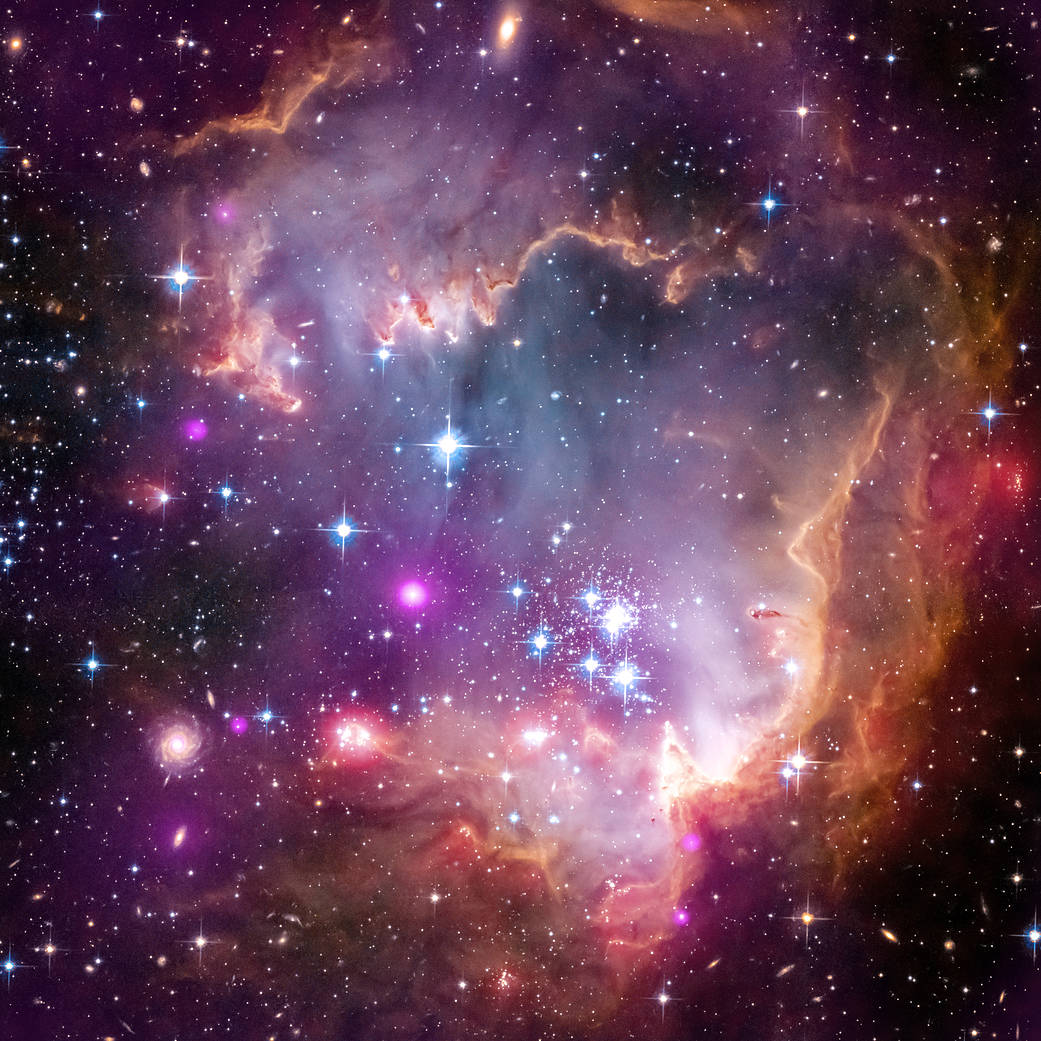The tip of the “wing” of the Small Magellanic Cloud galaxy is dazzling in this 2013 view from NASA’s Great Observatories. The Small Magellanic Cloud, or SMC, is a small galaxy about 200,000 light-years way that orbits our own Milky Way spiral galaxy.
The colors represent wavelengths of light across a broad spectrum. X-rays from NASA’s Chandra X-ray Observatory are shown in purple; visible-light from NASA’s Hubble Space Telescope is colored red, green and blue; and infrared observations from NASA’s Spitzer Space Telescope are also represented in red.
The spiral galaxy seen in the lower corner is actually behind this nebula. Other distant galaxies located hundreds of millions of light-years or more away can be seen sprinkled around the edge of the image.
The SMC is one of the Milky Way’s closest galactic neighbors. Even though it is a small, or so-called dwarf galaxy, the SMC is so bright that it is visible to the unaided eye from the Southern Hemisphere and near the equator. Many navigators, including Ferdinand Magellan who lends his name to the SMC, used it to help find their way across the oceans.
Modern astronomers are also interested in studying the SMC (and its cousin, the Large Magellanic Cloud), but for very different reasons. Because the SMC is so close and bright, it offers an opportunity to study phenomena that are difficult to examine in more distant galaxies. New Chandra data of the SMC have provided one such discovery: the first detection of X-ray emission from young stars, with masses similar to our sun, outside our Milky Way galaxy.
Image Credit: NASA/CXC/JPL-Caltech/STScI
在这张2013年由美国宇航局大天文台拍摄的照片中,小麦哲伦云星系的“翅膀”尖令人眼花缭乱。小麦哲伦云,或称SMC,是一个小星系,距离我们银河系的螺旋星系约20万光年。
这些颜色代表了广谱光的波长。来自NASA钱德拉X射线天文台的X射线以紫色显示;NASA哈勃太空望远镜发出的可见光为红色,绿色和蓝色;NASA的斯皮策太空望远镜的红外观测也以红色表示。
在下方角落里看到的螺旋星系实际上就在星云的后面。在这张照片的边缘可以看到其他距离我们数亿光年或更远的遥远星系。
SMC是银河系最近的星系之一。尽管它很小,也就是所谓的矮星系,但它非常明亮,从南半球和赤道附近都可以用肉眼看到。包括费迪南德·麦哲伦(Ferdinand Magellan)在内的许多航海家都用它来帮助寻找穿越海洋的路,麦哲伦的名字就是SMC的名字。
现代天文学家也对SMC(以及它的近亲,大麦哲伦星云)感兴趣,但原因截然不同。由于SMC距离我们如此之近且如此明亮,它提供了一个机会来研究在更遥远的星系中难以观测到的现象。钱德拉SMC的新数据提供了一个这样的发现:在银河系外首次检测到质量类似于太阳的年轻恒星发出的X射线。
图片来源:NASA/CXC/JPL-Caltech/STScI



